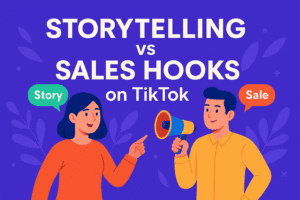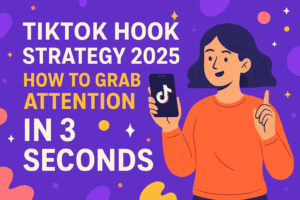Common Mistakes That Make TikTok Hook Fail
A weak hook doesn’t just disappoint your audience — it kills your retention rate, which is the #1 metric TikTok uses to decide if your video deserves more reach. Here are the most common mistakes creators make in 2025:
1. Overusing Clickbait
- What happens: You tease something shocking but never deliver, or you deliver it too late.
- Why it fails: TikTok’s algorithm detects early swipes. If people leave before the payoff, your video gets buried.
- Fix: Use curiosity, but show proof or value within the first 8–10 seconds. Example: Instead of “This will blow your mind…” → show a real before/after screenshot right away.
2. Starting with Confusion
- What happens: Your first frame is unclear — maybe your face appears with no context, or your intro rambles.
- Why it fails: Viewers don’t know why they should care, so they scroll.
- Fix: Make the first 3 seconds instantly clear. Start with a problem, a promise, or a striking visual.
3. Leaning on Clichés
- What happens: You open with “Hey guys,” “So today I wanted to talk about…” or other filler.
- Why it fails: TikTok is too fast for small talk. These intros waste your golden window.
- Fix: Replace fluff with value-driven lines:
- Bad: “Hey guys, I wanted to talk about TikTok growth.”
- Good: “If your TikToks keep dying at 200 views, this is why.”
4. Static Visuals
- What happens: Your first frame is just a still face with no movement, props, or text.
- Why it fails: TikTok is a motion-first platform. Static visuals feel dull and ad-like.
- Fix: Add motion in frame one: wave, toss something in, zoom in/out, or use bold text overlays.
Want to see what good hooks look like? Check out our guide to viral TikTok hook examples.
What the Algorithm Actually Picks Up On
Most creators think their hook “failed” because people didn’t like the idea. But in reality, TikTok’s algorithm doesn’t judge you on creativity or style — it judges you on data signals in the first 3 seconds. If your hook isn’t triggering the right signals, your video gets stuck in low reach. Here’s what the algorithm really looks at in 2025:
3-Second Retention (The Golden Metric)
- What it is: The percentage of viewers who stay past the first 3 seconds.
- Why it matters: TikTok uses this as the primary health check for your video. If retention dips below 50–60% in the first 3 seconds, distribution drops immediately.
- Fix: Audit your first frame. Does it show value, surprise, or motion right away? If not, your hook isn’t strong enough.
Average Watch Time (Beyond the Hook)
- What it is: How long people stay in your video on average.
- Why it matters: Even if people pass 3 seconds, they must keep watching for TikTok to trust your content. A 30-second video that averages only 5 seconds of watch time tells TikTok your hook didn’t match the delivery.
- Fix: Align the promise in your hook with what you actually deliver. No bait-and-switch.
Early Exits and Skip Penalty
- What it is: The skip rate when people swipe away in the first 1–5 seconds.
- Why it matters: In 2025, TikTok applies a skip penalty: repeated early exits on multiple videos reduce your overall profile distribution, not just the video’s.
- Fix: Test multiple hook variations. If one style gets skipped often, retire it and move on.
Engagement Signals Tied to Hooks
- What it is: How likes, comments, and shares correlate to early watch.
- Why it matters: TikTok weighs early engagement (within the first 10–15 seconds) more heavily. Hooks that trigger questions, surprises, or relatability are more likely to spark quick interactions.
- Fix: Build hooks around emotional triggers:
- Curiosity → “I bet you didn’t know this feature exists …”
- FOMO → “If you’re skipping this, your account will never grow …”
- Shock → “Stop using hashtags — they don’t matter anymore.”
Emotional Micro-Signals (The Hidden Factor)
- What it is: Micro behaviors like pausing, replaying, or watching silently.
- Why it matters: These subtle signals tell TikTok that your content is worth attention, even if not everyone engages directly. Hooks that surprise or raise tension are more likely to trigger replays.
- Fix: Add elements that encourage a second look: fast cuts, hidden text, quick visual transitions.
The algorithm doesn’t “care” about your editing skills or posting time — it cares about how many people you hold past 3 seconds and how well your hook matches your delivery. If your hooks keep failing, it’s not the idea — it’s the data signals you’re sending.
Want to compare weak vs. strong hooks? Check out Examples of Viral TikTok Hooks for formats that already pass TikTok’s algorithm tests.
Hook Rehab: From Flop to Scroll-Stopper
A bad hook doesn’t have to stay bad. With the right adjustments, you can turn weak intros into powerful attention magnets that keep viewers watching past the 3-second test. Here’s how to rehab failing hooks step by step:
Rewrite Weak Intros
- Flop: “Hey guys, I wanted to talk about TikTok growth …”
- Scroll-Stopper: “If your TikToks keep dying at 200 views, this is why.”
- Why it works: The second version eliminates fluff, calls out a pain point, and directly targets struggling creators.
Add Motion in the First Frame
- Flop: A static selfie with no movement.
- Scroll-Stopper: Tossing a notebook into frame, zooming in, or pointing at on-screen text.
- Why it works: TikTok is motion-first. Adding energy visually buys you those extra seconds.
Replace Clichés with Proof
- Flop: “This will blow your mind.”
- Scroll-Stopper: “This hook doubled my watch time overnight — here’s how.”
- Why it works: Proof-driven intros increase credibility and reduce swipes.
Use Niche-Specific Language
- Flop: “You won’t believe what happened when I tried this …”
- Scroll-Stopper: “You won’t believe what happened when I posted this video at midnight — as a beauty creator.”
- Why it works: Tailoring hooks to the audience makes them feel seen, increasing retention.
Test 3 Versions of Every Hook
Don’t guess — experiment. Try three variations of the same idea:
- Curiosity-driven version
- Proof-driven version
- Visual pattern-interrupt version
Pro tip: Track retention in TikTok Analytics → 3-second rate. Keep the winner, drop the losers.
Every weak hook can be salvaged with the right rewrite, motion, proof, and targeting. Treat your first 3 seconds as a data-driven experiment, not a guess. The creators who iterate win in 2025.
Real Examples of Fixes
Sometimes it’s easier to see why a hook fails — and how a small change can save it. Below are real before-and-after examples of TikTok hooks that went from flop to scroll-stopper.
The “Empty Greeting” Fix
- Flop: “Hey guys, welcome back to my channel …”
- Fix: “If your TikTok videos never pass 200 views, this is probably why.”
- Why it works: Cuts the fluff and speaks directly to a pain point.
The “Confusing Intro” Fix
- Flop: “So I was thinking about something that happened last week …”
- Fix: “This one mistake last week cut my views in half — don’t do it.”
- Why it works: Establishes relevance, stakes, and curiosity in the first 3 seconds.
The “Clickbait Without Proof” Fix
- Flop: “This will blow your mind …”
- Fix: “This one hook doubled my watch time overnight — here’s the screenshot.”
- Why it works: Moves from vague hype to specific proof, increasing trust and engagement.
The “Static Visual” Fix
- Flop: Talking head with no movement.
- Fix: Start with bold on-screen text (“STOP DOING THIS”), add a quick zoom, and hold up an example.
- Why it works: Visuals grab attention instantly, even for silent scrollers.
Case Study Style Fix
A creator tested three variations of the same video:
- Generic opening → retention dropped at 1.8 seconds.
- Proof-driven hook → retention jumped to 6.5 seconds.
- Proof + motion → retention averaged 8.9 seconds and earned 3x more likes.
Lesson: Testing hook variations is the fastest way to identify what the algorithm rewards.
Weak hooks don’t mean your content is bad. Most of the time, it’s just poor framing in the first 3 seconds. With small tweaks — clarity, proof, visuals, and niche focus — you can turn a failing hook into one that TikTok pushes to thousands.
Fix Your Hooks, Fix Your Growth
If your TikTok videos keep stalling at 200 views, it’s almost never about luck — it’s about the first 3 seconds. Weak hooks send the wrong signals to the algorithm, while strong ones trigger retention, engagement, and reach.
Now you know:
- The common mistakes that make hooks flop
- What the algorithm actually looks for in 2025
- Real examples of how to rehab weak intros into scroll-stoppers
But fixing your hooks is just the first step. To fully understand why hooks matter — and how to match them with storytelling, sales, or educational content — dive into our full guide: TikTok Hook Strategy 2025: How to Grab Attention in 3 Seconds
And if you’re ready to give your best hooks the push they need to go viral, don’t just rely on the algorithm. Pair them with engagement boosts, fix Your Engagement with Real TikTok Likes:
- Safe and fast delivery
- Works with TikTok’s 2025 algorithm
- Helps strong content escape the low-view trap
Your TikTok hooks aren’t failing because you’re “bad at content” — they’re failing because you haven’t treated the first 3 seconds as the deciding factor. Once you fix that, TikTok will finally reward your videos with the visibility they deserve.
Upgrade your hooks, test them relentlessly, and give them the momentum to break through. The difference between failure and growth is just a few seconds.














